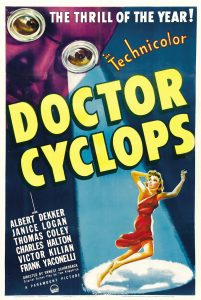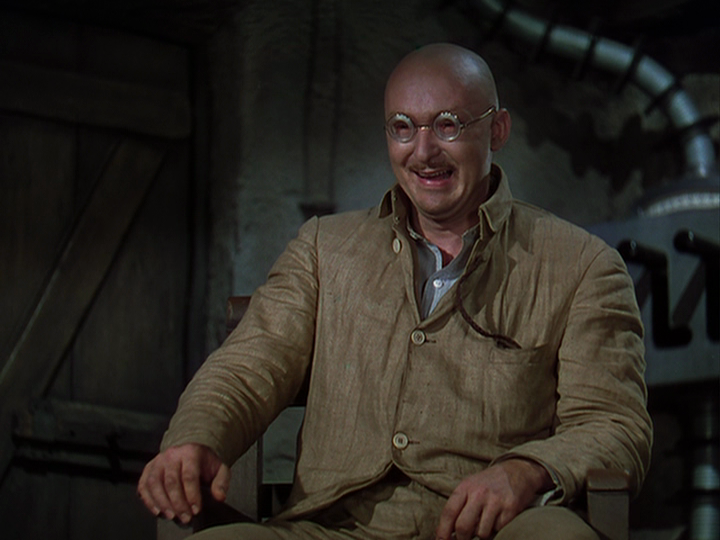“Now I can control life — absolutely!”
|

Synopsis:
A doctor (Albert Dekker) with failing eyesight invites three scientists (Thomas Coley, Janice Logan, and Charles Halton) to his laboratory deep in the South American jungles, hoping to seek their input on his work with radium. Soon the scientists, a mule driver (Victor Kilian), and Dekker’s assistant (Frank Yaconelli) find their lives at stake when the power-hungry Dekker miniaturizes them.
|
|
Genres, Themes, Actors, and Directors:
- Atomic Energy
- Mad Doctors and Scientists
- Science Fiction
Response to Peary’s Review:
Peary writes that this “conventional juvenile horror story benefits from solid special effects: it was the first time transparencies, split screens, and double exposures had been used in a color film”. As he notes, “the tiny people look authentic” — but unfortunately, that’s about all one can say about them, given that they barely have a chance to emerge as full-fledged characters (and rather uninteresting ones at that) before being reduced to doll-like figurines. The bulk of the movie involves the tiny group attempting to escape from hulking Dr. Thorkel (Dekker) and other menacing threats (a cat, cacti, etc.). It’s all very impressively filmed, but doesn’t offer enough narrative grit to hold one’s interest. Made in between The Devil Doll (1938) and The Incredible Shrinking Man (1957), Dr. Cyclops is less successful than either of these outings, but worth a look for its impressive early special effects.
Redeeming Qualities and Moments:
- Albert Dekker as Dr. Thorkel

- Excellent special effects


- Fine Technicolor cinematography

Must See?
No, though film fanatics should check it out once for the special effects.
Links:
|
One thought on “Dr. Cyclops (1940)”
First viewing. Not must-see, except for those who have a special interest in earlier achievements in special effects. Other than that, the film is as described accurately in the assessment. It’s a rather ho-hum flick, all told – and becoming more than marginally engaged in it is rather difficult.
One can certainly notice the effort on the part of director Ernest B. Schoedsack in the attempt to make the film more than it really is. (Schoedsack also directed ‘The Most Dangerous Game’, ‘Mighty Joe Young’ and was uncredited in working with his army buddy Merian C. Cooper on ‘King Kong’.)
Perhaps, with a better script, it might have been a better film.